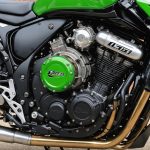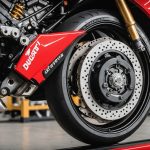Introduction to the Ducati 959 Panigale Exhaust System
The Ducati 959 Panigale is renowned for its precision engineering, and its exhaust system plays a pivotal role in enhancing performance. At its core, the system optimizes power delivery by effectively managing exhaust gases, which is critical for maximizing the engine’s potential. This not only boosts overall speed and acceleration but also improves fuel efficiency, making it an integral component for any motorcycle maintenance routine.
Regular maintenance of the exhaust system is essential. Neglect can lead to reduced efficiency, increased emissions, and potential damage. Routine checks ensure that the system remains clear of carbon build-up and any leaks are promptly addressed. This practice extends the life of the exhaust and maintains the high performance Ducati riders expect.
Additional reading : Discover stylish graphics kits for every motorcycle adventure
Common components within the exhaust system include:
- Headers, which collect exhaust gases from the engine cylinders
- Mufflers, responsible for reducing noise
- Pipes, which direct gases safely away from the rider
Understanding these parts, and their functionality, is crucial for effective maintenance. By familiarizing oneself with the system’s components, Ducati 959 Panigale owners can better address issues and maintain their motorcycle’s peak performance.
This might interest you : Explore trendy motorcycle graphic kits for all your rides
Routine Maintenance of the Exhaust System
Routine maintenance of your exhaust system is vital for optimal vehicle performance and longevity. Regular exhaust maintenance ensures the system is free of blockages, leaks, or rust, which can affect engine efficiency and safety.
To correctly perform maintenance, several steps should be followed. Start by conducting routine checks to inspect the exhaust system at recommended intervals, usually every 12,000 miles or annually, whichever comes first. These intervals help identify any potential issues early before they escalate.
During inspection, pay special attention to the exhaust pipes, mufflers, and catalytic converter for signs of wear or damage. Preventive care measures include tightening loose connections and removing rust using specialized cleaners. Always replace any defective parts with OEM parts to maintain the integrity and performance of the system. Original Equipment Manufacturer (OEM) parts are designed specifically for your vehicle, ensuring compatibility and high quality.
Preventive care not only prolongs the life of your exhaust system but also enhances fuel efficiency and reduces harmful emissions. By ensuring that routine checks and proper maintenance procedures are adhered to, you safeguard not just vehicle performance but also the environment. Implementing these practices keeps your vehicle running smoothly and cleanly.
Cleaning Methods for the Exhaust System
Regular maintenance of your vehicle’s exhaust system is crucial for optimal performance. To begin, select safe cleaning products specifically designed for metal surfaces. It is important to avoid using harsh chemicals that can damage the exhaust materials. Always wear protective gloves and eyewear to ensure safety.
Step-by-Step Cleaning Process
-
Preparation: Before getting started, ensure your car has cooled down completely. This prevents any risk of burns or injuries.
-
Product Application: Apply the chosen exhaust cleaning product onto a clean cloth. Gently rub the surface of the exhaust to remove grime and soot. Pay close attention to areas where buildup is substantial.
-
Rinse Thoroughly: Use water to rinse off any residues. This step is important to ensure that safe cleaning products don’t leave any film that may attract more dirt.
Common Mistakes to Avoid
-
Skipping the Cooling Step: Cleaning a hot exhaust can not only be dangerous but might also lead to product evaporation before it has time to work.
-
Using Abrasive Tools: Avoid using scouring pads, as they can scratch and damage the exhaust surface.
Keeping these maintenance tips in mind will help maintain your exhaust system’s longevity and efficiency.
Identifying Exhaust System Parts
Understanding exhaust components is crucial whether you own a Ducati 959 or any other motorbike. Each part of the exhaust system plays a vital role in your vehicle’s performance and efficiency. Let’s explore key Ducati 959 parts and their functions.
Muffler
The muffler is a standout among exhaust components. Its primary function is to silence the noise produced by the engine during combustion. You can visually identify the muffler as the larger bulging section of the exhaust, usually located towards the end of the system. Common issues include rust and internal baffle failures, which can cause loud exhaust noises.
Headers
Serving as the starting point of the exhaust system, headers connect directly to the engine’s cylinders. They guide the exhaust gases from the combustion chamber into the exhaust system. Typically, headers are easy to spot due to their tube-like appearance at the engine’s top. Cracks and rust are prevalent issues that can lead to leaks or performance inefficiencies.
Catalytic Converter
The catalytic converter transforms harmful emissions into less toxic substances. Positioned between the headers and the muffler, it resembles a metallic box. Keep an eye out for symptoms like increased emissions or reduced engine performance, as these may signal blockages or failures in the catalytic converter.
Troubleshooting Common Exhaust Issues
Understanding the intricacies of exhaust problems is crucial to maintaining a vehicle’s performance and safety. Early diagnosis of such issues could prevent more extensive damage.
Warning Signs of Exhaust Issues
Identifying potential exhaust problems early can save you from costly repairs. Be on the lookout for symptoms like unusual noises (such as hissing or popping), which often indicate an exhaust leak. Additionally, if you notice vibrations in the steering wheel or gas pedal, this might point to a malfunction within your exhaust system. Another red flag is decreased fuel efficiency, signifying the system is not working as effectively.
How to Diagnose Common Problems
Accurate troubleshooting begins with visual inspections. Have a look for visible cracks or holes in the exhaust pipes. If these signs aren’t apparent, further diagnostic tips include listening for changes in engine noise and performing a ‘soapy water test’ to reveal leaks: apply soapy water to suspected areas and look for bubbling when the engine runs.
Solutions for Fixing Exhaust Leaks
Once diagnosed, solutions can vary from simple repairs to more complex fixes. Small leaks might be resolved using exhaust sealant or tape, while larger issues could require part replacement. Always ensure repairs are aligned with exhaust system specifications, maintaining overall vehicle safety and performance.
Enhancing Exhaust Performance
Performance upgrades can significantly enhance your vehicle’s capabilities. One popular route is exhaust modifications, which include adjustments to pipes and mufflers. By replacing stock pipes and mufflers with high-performance alternatives, you allow exhaust gases to exit more efficiently, reducing back pressure and increasing horsepower. Not only does this improve the sound, giving it a desirable growl or roar tailored to your preference, but it also optimizes overall engine performance, enabling faster acceleration and improved fuel efficiency.
A fascinating aspect of exhaust optimization is its role in the vehicle’s tuning process. Tuning can further refine how your engine responds. Once you modify the exhaust, adjusting the engine’s control unit to align with these changes ensures that you maximise the performance potential. Tools for tuning can recalibrate air and fuel ratios, timing, and other engine parameters to enhance the modifications’ impact.
Exhaust modifications are celebrated for their noticeable boosts in performance. Enthusiasts often recommend them as a gateway into the world of car upgrades. They offer a blend of aesthetic and functional benefits, making them a favourite among those seeking to maximize both sound and speed. Consider these modifications if you wish to explore extensive performance capability improvements without compromising reliability.
Recommended Products for Exhaust Care
Choosing the right product recommendations for your vehicle’s exhaust care is essential. Proper maintenance keeps your exhaust system functioning efficiently and prolongs its life. To start, consider investing in top maintenance products known for their effectiveness.
Cleaning supplies are vital in removing soot and dirt, ensuring your exhaust remains unobstructed for optimal performance. Many of these products have been reviewed positively for their ease of use and impressive results. Whether it’s a spray or a paste, selecting the right cleaning supplies can be a game-changer for your exhaust system.
Next, look into reviews of popular exhaust upgrade options to identify which enhancements suit your needs best. These reviews can guide you toward performance boosts, like improved fuel efficiency or sound modification.
Lastly, finding reliable parts and accessories is crucial. The right retailers offer a range of cleaning supplies and upgrade kits, guaranteeing quality and compatibility with your vehicle. Remember to check for warranties and customer support when purchasing parts. By considering these product recommendations, you can keep your exhaust system in top condition and achieve desired performance enhancements.
Safety Considerations for Exhaust System Care
When maintaining a motorcycle’s exhaust system, prioritising safety is crucial. Awareness of the importance of motorcycle care ensures both you and your bike remain in optimal condition. A significant aspect is using appropriate personal protective equipment. Gloves, goggles, and heat-resistant clothing are essential during any maintenance activity to protect against burns or injuries.
Maintenance safety also demands attention to handling heated components. After a ride, exhaust parts retain heat and can cause severe burns. Allow sufficient cooling time before commencing any work. Understanding safe handling procedures is fundamental when dealing with these potentially dangerous elements.
Moreover, adhering to manufacturer guidelines is non-negotiable. Each motorcycle model may have specific requirements, and these instructions will often include crucial safety tips. Following these ensures the integrity of the exhaust system while safeguarding the user during motorcycle care.
In summary, prioritising safety during maintenance involves using personal protective gear, allowing parts to cool before handling, and strictly following manufacturer recommendations. These precautions promote both user safety and the longevity of the motorcycle’s exhaust system, ultimately enhancing the overall riding experience.











